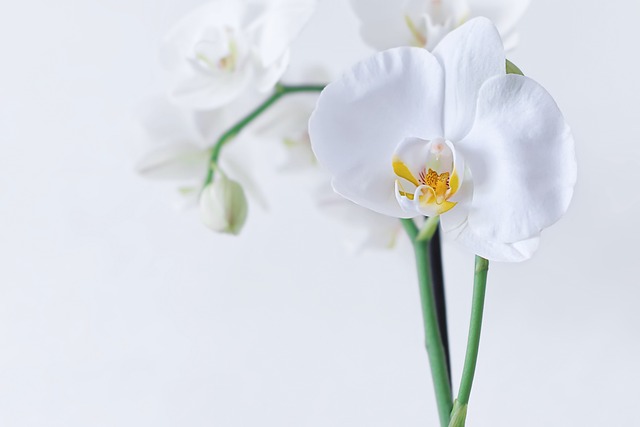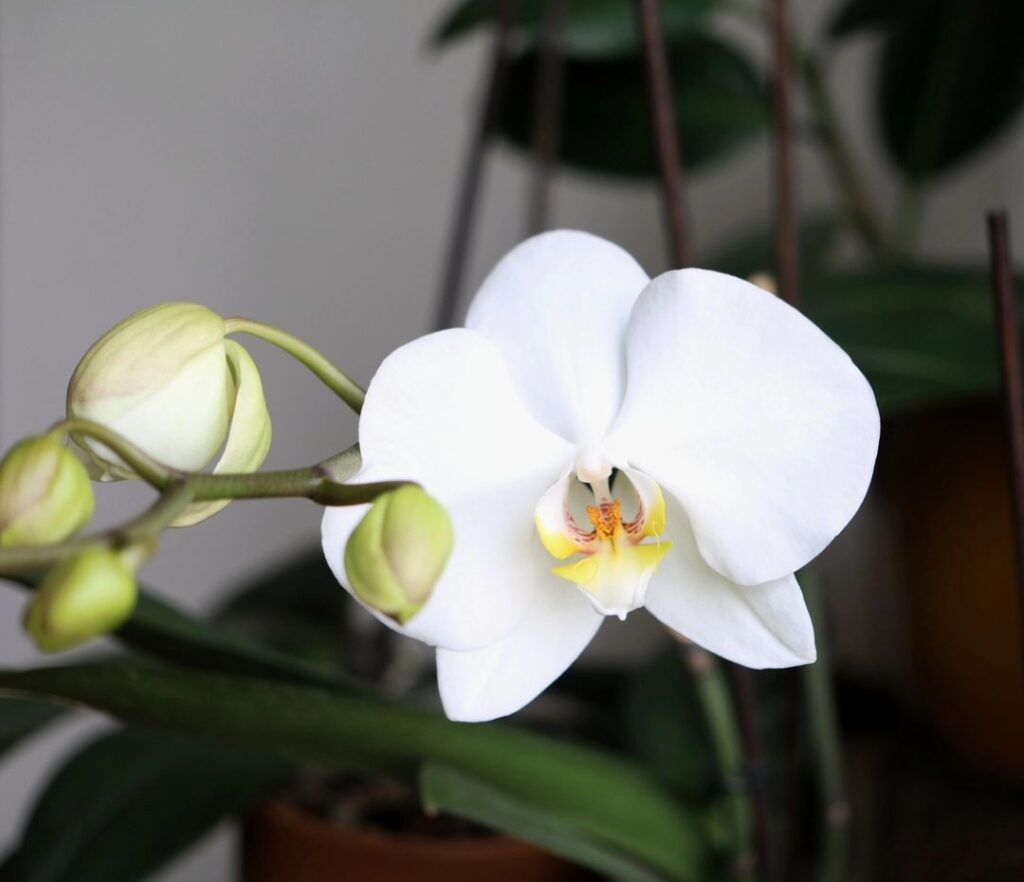
Phalaenopsis amabilis, is a fascinating species that has captured the hearts of orchid lovers all around the world. Native to Southeast Asia, this stunning orchid is celebrated for its exquisite blooms and relatively easy care, making it a popular choice for both novice and experienced growers. In this guide, we’ll explore everything you need to know about caring for Phalaenopsis amabilis and ensuring it thrives in your home.

- 1 Overview of Phalaenopsis Amabilis
- 2 To successfully grow Phalaenopsis amabilis, it’s essential to recreate its natural environment:
- 3 Potting and soil requirements
- 4 Watering Practices
- 5 Watering Schedule:
- 6 Fertilising Phalaenopsis Amabilis
- 7 Pruning and grooming
- 8 Common Issues and Troubleshooting
- 9 FAQS
Overview of Phalaenopsis Amabilis
Phalaenopsis amabilis features broad, flat petals that often showcase a pristine white colour, sometimes with delicate hints of pink or yellow in the ntry. The blossoms can have a diameter of up to 4-5 inches, which makes for a visually arresting display that can continue for several months. This orchid symbolises love and beauty, making it an ideal gift for special occasions and a treasured addition to any collection. Its graceful appearance and long-lasting blooms contribute to its popularity, as it can bloom multiple times a year under the right care conditions.
Ideal Growing Conditions
To successfully grow Phalaenopsis amabilis, it’s essential to recreate its natural environment:
Temperature Requirements: This orchid thrives in temperatures ranging from 65°F to 85°F (18°C to 29°C). Nighttime temperatures should ideally be a few degrees colder. Sudden temperature fluctuations can stress the plant, leading to dropped flowers or stunted growth, so it’s important to provide a stable environment.
Light Requirements: Phalaenopsis amabilis prefers bright, indirect sunlight. While too little sunlight can prevent blossoming, too much can scorch the leaves. Try to get between 10 and 12 hours of light each day. A location near an east or west-facing window works well, but if natural light is insufficient, consider using grow lights to supplement.
Humidity Levels: High humidity (50–70%) is crucial for the health of this orchid. You can maintain humidity by using a humidity tray filled with water and pebbles, misting the leaves regularly, or placing the orchid in a bathroom with good light. Maintaining adequate humidity not only supports the orchid’s growth but also helps to prevent pests and diseases.
Best Zones for Growing: Phalaenopsis amabilis thrives in USDA Hardiness Zones 10–12, making it ideal for regions with tropical or subtropical climates. If you live in cooler areas, consider growing this orchid indoors where you can control its environment.
Potting and soil requirements
Choosing the right potting medium is vital for healthy root development.
Potting Medium: Use a well-draining mix, such as orchid bark or sphagnum moss, to prevent root rot. Regular potting soil should be avoided since it holds too much moisture. The right medium allows for air circulation and moisture retention, mimicking the orchid’s natural growing conditions.
Pot Selection: Plastic pots are great for retaining moisture, while clay pots offer better airflow. Choose a pot size that allows for adequate root growth without being too spacious, as excess space can lead to water retention issues.
Watering Practices
Proper watering techniques are crucial for the health of Phalaenopsis amabilis. The following timetable can help you maintain the right watering schedule throughout the year:
Watering Schedule:
Summer Watering: Water every 5–7 days. During hot weather, check the moisture level frequently, as the potting medium can dry out quickly. If the leaves start to wrinkle, it’s a sign that the plant needs water.
Winter Watering: Water every 10–14 days. Adjust the frequency based on the indoor temperature and humidity levels. In winter, the plant’s water needs decrease, so it’s essential to avoid overwatering, which can lead to root rot.
| Season | Watering Frequency |
|---|---|
| Spring | Every 5-7 days |
| Summer | Every 5-7 days |
| Fall | Every 7-10 days |
| Winter | Every 10-14 days |
Watering Methods: Always use room temperature water to avoid shocking the plant. Water thoroughly until excess drains out of the bottom of the pot, and ensure the potting medium is dry before the next watering to prevent root rot.
Fertilising Phalaenopsis Amabilis
fertilisation helps your orchid thrive and promotes vibrant blooms.
Types of Fertilisers: Use a balanced orchid fertiliser every two to four weeks during the growing season (spring and summer). This nutrient boost is essential for supporting the orchid’s growth and flowering cycles.
Tips for Effective Fertilisation: Dilute the fertiliser to half strength to avoid burning the roots. Reduce or stop fertilising during the dormant season in fall and winter, when the plant’s growth slows.
Pruning and grooming
Regular maintenance ensures your orchid stays healthy and encourages future blooms.
Grooming: Remove any dead or yellowing leaves to promote healthy growth. Cleaning the leaves gently with a damp cloth helps prevent dust buildup, which can hinder photosynthesis and overall plant health.
Pruning Flower Spikes: After the blooms fade, cut the flower spike back to encourage new growth. If a keiki (baby orchid) appears on the spike, allow it to grow until it develops roots before separating it from the mother plant. This practice can lead to a thriving new plant.
Common Issues and Troubleshooting
Like all plants, Phalaenopsis amabilis can face challenges that require attention:
Identifying Pests and Diseases: Common pests include aphids and mealybugs, while fungal and bacterial infections can occur in overly moist conditions. Check your orchid frequently for any indications of trouble, such as discoloured leaves or a sticky residue on the foliage.
Solutions and Prevention Tips: Use organic pest control methods, such as insecticidal soap or neem oil, to address pest problems. Maintain proper watering and humidity levels to prevent disease. Healthy orchids are more resilient, so consistent care is key.
Caring for Phalaenopsis amabilis can be a rewarding experience, bringing beauty and elegance into your home. By providing the right conditions, consistent watering, and regular maintenance, you can enjoy stunning blooms for many years. Embrace the joy of growing the moon orchid and watch it thrive in your care! Happy orchids.
FAQS
How often should I water my Phalaenopsis amabilis?
The watering frequency for Phalaenopsis amabilis varies by season. In the summer, water every 5–7 days, ensuring the potting medium is dry before the next watering. In winter, water less frequently, approximately every 10–14 days, as the plant’s water needs decrease during its dormant period. To avoid root rot, always use water at room temperature and make sure drainage is adequate.
What light conditions are best for Phalaenopsis amabilis?
Phalaenopsis amabilis thrives in bright, indirect sunlight. An ideal location is near an east or west-facing window, where the plant can receive filtered light for about 10–12 hours each day.To prevent scorching the leaves, stay out of direct sunshine. If there’s not enough natural light, think about adding grow lights.
What type of potting medium should I use for Phalaenopsis amabilis?
A well-draining potting mix is essential for Phalaenopsis amabilis. Use a blend of orchid bark, sphagnum moss, or a commercial orchid mix that allows for air circulation and moisture retention. Regular potting soil should be avoided since it holds too much moisture and can cause root rot.
How can I encourage my Phalaenopsis amabilis to bloom?
To encourage blooming, provide your Phalaenopsis amabilis with proper care, including adequate light, temperature, and humidity. Fertilise every two to four weeks during the growing season (spring and summer) using a balanced orchid fertilizer. Additionally, ensure the plant has a temperature drop of about 10°F (5°C) at night for a few weeks, as this can stimulate flowering. After the blooms fade, prune the flower spike to encourage new growth and future blooms.





